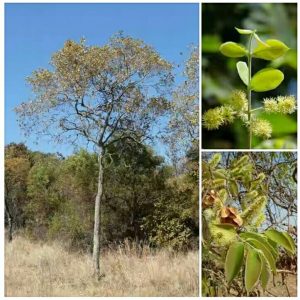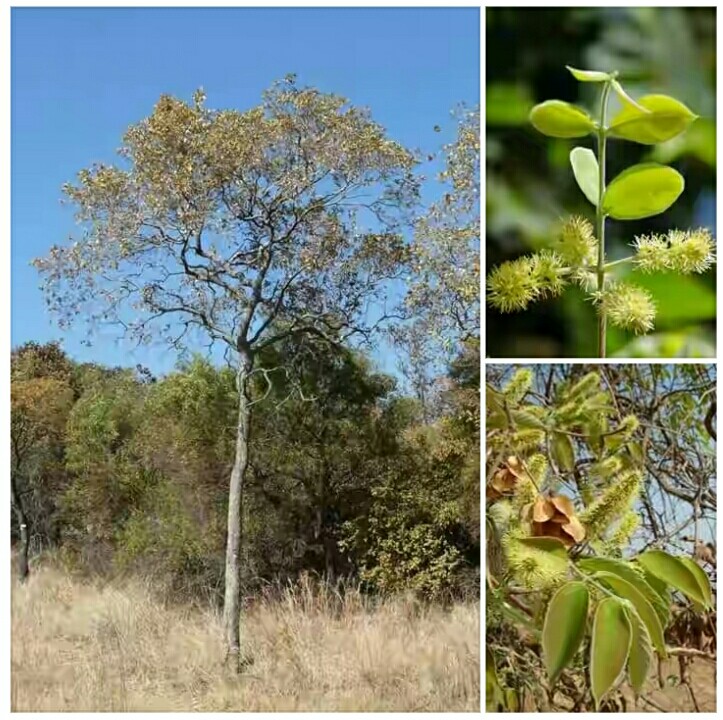Combretum molle; synonyms: Combretum arbuscular, Combretum atalanthum, Combretum gueinzii, Combretum holosericeum, Combretum splendens, Combretum ulugurense (Botanical/scientific name) or Velvet leaf willow, Velvet leaf combretum, Velvet bush-willow (English) or Wuyan damo, Gogen damo, Goda jiki, Ɗinyar gata (Hausa) or Damoruhi, Bodi (Fula-Fulfulde) or Aragba (Yoruba): An important African plant of the Combretaceae family
CHARACTERISTICS, DESCRIPTION AND OCCURRENCE:
Velvet bush willow is a small to medium-sized evergreen deciduous trees that grows up to 13 m high, with rounded crown. It has grey bark when still young and this becomes grey-brown or almost black when older. The trunk is crooked or leaning, occasionally swollen at the base, up to 30 cm in diameter.
Bark grey and smooth when young, grey-brown to almost black, rough and flaking when older, twigs often with reddish hairs. Branching is heavy and drooping, giving a rounded or flat-rounded, sometimes oval, crown. It may be evergreen or deciduous and yields a gum.
The leaves are simple, opposite, densely covered by velvety hairs when immature and smoother when mature. Young leaves are attractive with light pink or orange colour. Its flowering time is Sept.-Nov in South Africa. The flowers are in dense axillary spikes with greenish yellow colour, strongly scented and attractive to bees and other insects.
The fruit is four-winged, about 20 mm in diameter, light green with reddish shade which turns red-brown when dry. Individual flowers are small on bare branches; pale cream or greenish-yellow, sometimes with a reddish tinge; heavily scented, borne singly in the axils of the leaves; in dense, axillary, often branched spikes, 4-9 cm long. The short-stalked flowers are borne on a central stalk 3-7 cm long. Bracts present.
Fruits are yellowish-green flushed with red, drying to golden reddish-brown; borne abundantly, some old fruits remaining on the tree into the next flowering season; 4-winged, the wings pale yellow-brown, rounded, with shallow notches at top and bottom.
Combretum was the name given by Pliny to a particular climbing plant, the identity of which has been lost in time. The specific name is the Latin word ‘mollis’, meaning ‘soft’, presumably because of the softness of the leaves. Combretum molle occurs throughout tropical Africa, avoiding the humid forest areas. It occurs also in South Africa and in Yemen.
It is a tree of the bush and savannah regions of Africa generally, often occurring on ant-hills, in semi-evergreen thickets and frequently associated with quartzite formations.
Combretum molle is considered a very polymorphic aggregate species as it is extremely variable in leaf shape, leaf reticulation, hairiness and size of the fruits. The plant is native to: Botswana, Cameroon, Central African Republic, Chad, Congo, Democratic Republic of Congo, Djibouti, Eritrea, Ethiopia, Gabon, Ghana, Kenya, Lesotho, Namibia, Niger, Nigeria, Senegal, Somalia, South Africa, Sudan, Swaziland, Tanzania, Uganda, Zambia.
USES/IMPORTANCE/HEALTH BENEFITS
Wuyan damo has been found to possess good field of pharmacognosy and pharmacology and to be effective against bacteria, fungi and helminthes. It is a medicinal plant with many applications in traditional medicine. Boiled root decoction is used to induce abortion and treat constipation, leprosy, headaches, stomach pains, fever, dysentery, general pains, swellings and as an anthelmintic for hookworm.
The root and leaf together are believed to be an antidote for snake bite; leaves are chewed or pounded, soaked in water and the juice drunk for chest complaints and as an anthelmintic, or they are used as an inhalant in hot steam bath. An infusion of the inner bark is taken orally or as an enema to relieve various stomach ailments.

The bark exudes a gum that can be used to treat wounds, or crushed dried or fresh leaves can be used for the same purpose. An infusion or decoction of the roots, stem bark or leaves is taken to treat large variety of intestinal problems, including abdominal pain, colic, constipation, intestinal worms and dysentery, and further to treat fever, malaria, jaundice, oedema, headache, backache, leprosy, HIV infections, cough, angina, tuberculosis and other chest complaints.
It is also used to induce abortion and to treat post-partum bleeding. Sometimes a fruit decoction is taken after a difficult delivery. The plant is used, in the absence of the more popular ‘kinkeliba’ (Combretum micranthum or Geza, Farar geza in Hausa) for treating jaundice and yellow fever, abdominal complaints, diarrhoea etc., blennorrhoea, anuria, etc., and sometimes to women in childbirth to hasten the expulsion of the after-birth .
A decoction of the roots, mixed with the roots of several other plant species is drunk to treat impotence, syphilis and female sterility and also as an aphrodisiac. Crushed fresh leaves, gum from the bark or powdered inner part of the root is applied as a wound dressing. A leaf decoction or dried leaves is used to wash wounds and to treat itch and skin infections.
The crushed fresh roots or leaves, alone or mixed with other plants are applied to snakebites, and an infusion of the pounded root or stem bark is taken to treat the same. The breasts are washed with a root extract as a galactagogue (stimulation of flow of breast milk). A leaf decoction or dried leaves are fed to sheep to treat intestinal worms.
The wood is yellow, hard coarse, brittle when dry and difficult to work. It is considered to be reasonably termite resistant. It is suitable for farm implements, stools, mortars, drums, construction poles and fence posts. C. molle is one of the widely used sources of fuel wood and high quality charcoal. The wood burns slowly, giving intense heat.
A red or black dye can be obtained from the leaves and a yellow dye from the roots. The sweetly scented flowers attract bees and make good forage for honey production. The leaves are readily browsed by livestock and game, and can also be used for mulching.
Leaf fall is a source of mulch and green manure for the soil. The bark slash exudes a gum, which has been a minor source of trade in Northern Nigeria, but it is considered of lower quality than the gum Arabic. The use of C. molle as a firewood is locally prohibited due to magico-religious reasons.
C. molle contains very important bioactive substances. Several stem bark extracts showed highly significant antibacterial, antiprotozoal and antifungal activities.
In several mammalian experimental models, mollic acid glucoside showed significant cardiovascular effects, including bradycardia, vasorelaxation (relaxation of blood vessels) and hypotension (decrease in blood pressure).
The compound also showed significant analgesic (pain killing) and anti-inflammatory activities in laboratory animals, and also produced hypoglycemic (decrease in blood sugar) and anti-diabetic effects. Punicalagin – another bioactive compound found in C. molle showed significant antibacterial activity as well as selective inhibition of HIV-1 replication. C. molle is widely used as a medicinal plant in rural communities.
Although pharmacological research corroborates its traditional internal uses against a range of pathogenic organisms, clinical tests to confirm its safe use would be of great value. It would also be useful to evaluate its pharmacological properties with regards to its use for HIV- and tuberculosis-related illnesses.
Domestication or controlled harvesting practices are worth further investigation as a sustainable conservation measure. Trees are fast growing; lopping and coppicing are suitable practices. Seed storage behaviour is orthodox; seeds can be stored for long periods under favourable conditions.
FOR FURTHER READING SEE:
1. Asres K., Mazumder A., Bucar F. Antibacterial and antifungal activities of extracts of combretum molle. Ethiop Med J. 2006l; 44(3):269-77.
2. Atindehou, K.K., Schmid, C., Brun, R., Koné, M.W. & Traoré, D., 2004. Antitrypanosomal and antiplasmodial activity of medicinal plants from Côte d’Ivoire. Journal of Ethnopharmacology 90(2): 221–227.
3. Coates Palgrave, M. 2002. Keith Coates Palgrave Trees of southern Africa, edn 3. Struik, Cape Town.
4. Grant, R. & Thomas, V.1999. Sappi tree spotting. Tree identification made easy. KwaZulu-Natal coast and Midlands. Jacana, Johannesburg.
5. Iwu M., Maurice. Handbook of African Medicinal Plants. Boca Raton, Florida, CRC Press, 1993.
6. Ojewole, John A.O., Analgesic and antiinflammatory effects of mollic acid glucoside, a 1α-hydroxycycloartenoid saponin extractive from Combretum molle R. Br. ex G. Don (Combretaceae) leaf. Phytotherapy Research John Wiley & Sons, Ltd. 2008; 22: 30-35.
These are the thoughts and intellectual property of:
Sa’eed Halilu Bawa
Senior Lecturer (Associate Professor) at University of the West Indies, St. Augustine Campus, Trinidad.
Studied Food and Nutrition Sciences, Dietetics at Kaduna Polytechnic, Nigeria; Warsaw University of Life Sciences, Poland.
























